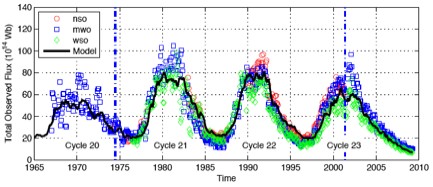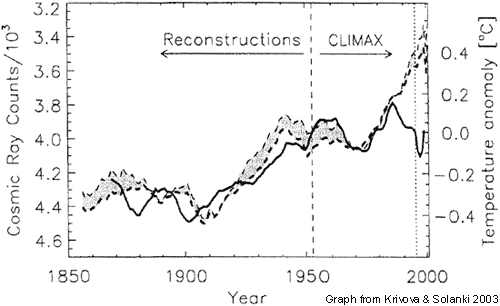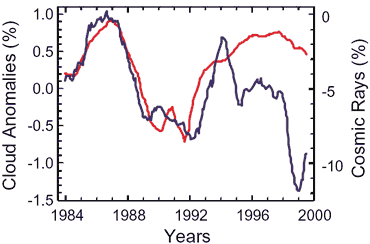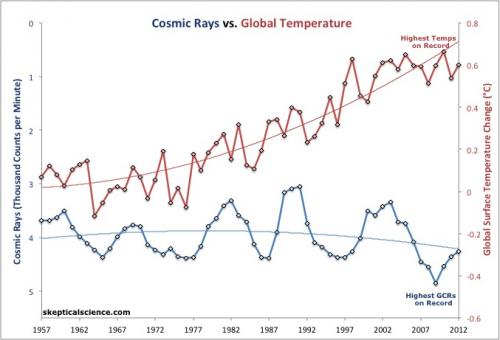What's the link between cosmic rays and climate change?
What the science says...
| Select a level... |
 Basic
Basic
|
 Intermediate
Intermediate
|
 Advanced
Advanced
| ||||
|
Hypothetically, an increasing solar magnetic field could deflect galactic cosmic rays, which hypothetically seed low-level clouds, thus decreasing the Earth's reflectivity and causing global warming. However, it turns out that none of these hypotheticals are occurring in reality, and if cosmic rays were able to influence global temperatures, they would be having a cooling effect. |
|||||||
It's cosmic rays
"When the Sun is active, its magnetic field is better at shielding us against the cosmic rays coming from outer space, before they reach our planet. By regulating the Earth’s cloud cover, the Sun can turn the temperature up and down. ... As the Sun’s magnetism doubled in strength during the 20th century, this natural mechanism may be responsible for a large part of global warming seen then." (Henrik Svensmark)
Henrik Svensmark has proposed that galactic cosmic rays (GCRs) could exert significant influence over global temperatures (Svensmark 1998). The theory goes that the solar magnetic field deflects GCRs, which are capable of seeding cloud formation on Earth. So if the solar magnetic field were to increase, fewer GCRs would reach Earth, seeding fewer low-level clouds, which are strongly reflective. Thus an increased solar magnetic field can indirectly decrease the Earth's albedo (reflectivity), causing the planet to warm. Therefore, in order for this theory to be plausible, all four of the following requirements must be true.
-
Solar magnetic field must have a long-term positive trend.
-
Galactic cosmic ray flux on Earth must have a long-term negative trend.
-
Cosmic rays must successfully seed low-level clouds.
-
Low-level cloud cover must have a long-term negative trend.
Fortunately we have empirical observations against which we can test these requirements.
Solar magnetic field
Solar magnetic field strength correlates strongly with other solar activity, such as solar irradiance and sunspot number. As is the case with these other solar attributes, solar magnetic field has not changed appreciably over the past three decades (Lockwood 2001).

Figure 1: Solar Magnetic Flux from 1967 to 2009 (Vieira and Solanki 2010)
Galactic Cosmic Ray Flux
Cosmic ray flux on Earth has been monitored since the mid-20th century, and has shown no significant trend over that period.
Figure 2: Cosmic Ray Intensity (blue) and Sunspot Number (green) from 1951 to 2006 (University of New Hampshire)
In fact cosmic ray flux has lagged behind the global temperature change since approximately 1970 (Krivova 2003).
"between 1970 and 1985 the cosmic ray flux, although still behaving similarly to the temperature, in fact lags it and cannot be the cause of its rise. Thus changes in the cosmic ray flux cannot be responsible for more than 15% of the temperature increase"

Figure 3: Reconstructed cosmic radiation (solid line before 1952) and directly observed cosmic radiation (solid line after 1952) compared to global temperature (dotted line). All curves have been smoothed by an 11 year running mean (Krivova 2003).
Benestad (2013) compared cosmic ray flux to global surface temperature changes and found "there is little empirical evidence that links GCR to the recent global warming." In fact, since 1990, galactic cosmic ray flux on Earth has increased - "the opposite direction to that required to explain the observed rise in global mean temperatures" (Lockwood 2007). In fact, cosmic ray on flux recently reached record levels. According to Richard Mewaldt of Caltech, "In 2009, cosmic ray intensities have increased 19% beyond anything we've seen in the past 50 years." Erlykin et al. (2013) noted (emphasis added),
"Recent measurements of the cosmic ray intensity show that a former decrease with time has been reversed. Thus, even if cosmic rays enhanced cloud production, there would be a small global cooling, not warming."

Figure 4: Record cosmic ray flux observed in 2009 by the Advanced Composition Explorer (NASA)
Despite this record high GCR flux which we would expect to increase cloud cover and cause cooling, 2009 was tied for the second-hottest year on record, and the 12-month running mean global surface temperature record was broken 3 times in 2010 (NASA GISS).
Figure 5: Annual average GCR counts per minute (blue - note that numbers decrease going up the left vertical axis, because lower GCRs should mean higher temperatures) from the Neutron Monitor Database vs. annual average global surface temperature (red, right vertical axis) from NOAA NCDC, both with second order polynomial fits.
GCR Cloud Seeding
In order for GCRs to successfully seed clouds, they must achieve the following three steps.
-
GCRs must induce aerosol formation
-
These newly-formed aerosols must grow sufficiently (through the condensation of gases in the atmosphere) to form cloud-condensation nuclei (CCN)
-
The CCN must lead to increased cloud formation.
The first step is not controversial, and is being investigated by the CERN CLOUD experiment. A recent study by Enghoff et al. (2011) also demonstrated some success in inducing aerosol formation under laboratory conditions, although they have yet to test the process under atmospheric conditions.
However, the second step is often glossed over by those espousing the GCR warming theory. Freshly nucleated particles must grow by approximately a factor of 100,000 in mass before they can effectively scatter solar radiation or be activated into a cloud droplet (Verheggen 2009). Pierce and Adams (2009) investigated this second step by using a a general circulation model with online aerosol microphysics in order to evaluate the growth rate of aerosols from changes in cosmic ray flux, and found that they are far too small to play a significant role in cloud formation or climate change.
"In our simulations, changes in CCN from changes in cosmic rays during a solar cycle are two orders of magnitude too small to account for the observed changes in cloud properties; consequently, we conclude that the hypothesized effect is too small to play a significant role in current climate change."
Numerous studies have also investigated the effectiveness of GCRs in cloud formation (the third step). Kazil et al. (2006) found:
"the variation of ionization by galactic cosmic rays over the decadal solar cycle does not entail a response...that would explain observed variations in global cloud cover."
Sloan and Wolfendale (2008) found:
"we estimate that less than 23%, at the 95% confidence level, of the 11-year cycle changes in the globally averaged cloud cover observed in solar cycle 22 is due to the change in the rate of ionization from the solar modulation of cosmic rays."
Kristjansson et al. (2008) found:
"no statistically significant correlations were found between any of the four cloud parameters and GCR"
Calogovic et al. (2010) found:
"no response of global cloud cover to Forbush decreases at any altitude and latitude."
Kulmala et al. (2010) found
"galactic cosmic rays appear to play a minor role for atmospheric aerosol formation events, and so for the connected aerosol-climate effects as well."
Laken et al. (2013) found
"there is no robust evidence of a widespread link between the cosmic ray flux and clouds."
Krissansen-Totton & Davies (2013) found
"no statistically significant correlations between cosmic rays and global albedo or globally averaged cloud height, and no evidence for any regional or lagged correlations"
In the CERN CLOUD experiments, Almeida et al. (2013) found
"ionising radiation such as the cosmic radiation that bombards the atmosphere from space has negligible influence on the formation rates of these particular aerosols [that form clouds]"
Although there was a correlation between GCRs and low-level cloud cover until about 1991, after that point the correlation broke down (Laut 2003) and cloud cover began to lag GCR trends by over 6 months, while cloud formation should occur within several days (Yu 2000).

Figure 6: Low cloud cover (blue line) versus cosmic ray intensity (red line) (Laut 2003).
Low-Level Cloud Cover
Unfortunately observational low-level cloud cover data is somewhat lacking and even yields contradictory results. Norris (2007) found
"Global mean time series of surface- and satellite-observed low-level and total cloud cover exhibit very large discrepancies, however, implying that artifacts exist in one or both data sets....The surface-observed low-level cloud cover time series averaged over the global ocean appears suspicious because it reports a very large 5%-sky-cover increase between 1952 and 1997. Unless low-level cloud albedo substantially decreased during this time period, the reduced solar absorption caused by the reported enhancement of cloud cover would have resulted in cooling of the climate system that is inconsistent with the observed temperature record."
So the jury is still out regarding whether or not there's a long-term trend in low-level cloud cover.
Lack of evidence for significant historical climate impacts
Sloan & Wolfendale (2013) examined the influence of cosmic rays on the climate over the past billion years. They found that changes in the galactic cosmic ray intensity are too small to account for significant climate changes on Earth. This was also the conclusion of Feng & Bailer-Jones (2013).
Inability to explain other observations
In addition to these multiple lines of empirical evidence which contradict the GCR warming theory, the galactic cosmic ray theory cannot easily explain a number of observed fingerprints of the increased greenhouse effect, such as the cooling of the upper atmosphere and greater warming at night than day.
Additionally, because cosmic radiation shows greater variation in high latitudes, we expect larger changes in cloud cover in polar regions if GCRs are succesfully influencing cloud cover. This is not observed. Furthermore, examining the nuclear reactor accident at Chernobyl, ionization from the radioactivity would be expected to have produced an increase in cloud cover. There is no evident increase in cloud cover following the accident (Sloan & Wolfendale 2007).
Galactic cosmic rays can't explain global warming
In summary, studies have shown that GCRs exert a minor influence over low-level cloud cover, solar magnetic field has not increased in recent decades, nor has GCR flux on Earth decreased. In fact, if GCRs did have a significant impact on global temperatures, they would have had a net cooling effect over the past 50 years, especially over the past 50 years when global warming was strongest. Sloan & Wolfendale (2013) found that the contribution of solar activity and galactic cosmic rays (combined) to global warming is "less than 10% of the warming seen in the twentieth century."
Last updated on 14 October 2016 by dana1981. View Archives































 Arguments
Arguments













































Climate Myth...